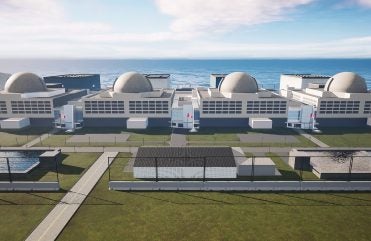
Candu Energy, an AtkinsRéalis company and original equipment manufacturer of Candu technology, is entering into a special project with the Canadian Nuclear Safety Commission (CNSC) to develop a plan for a Pre-Licensing Design Review of the new Candu Monark reactor. This will consider its suitability to be licensed and built in Canada.
“Reactor development is a key differentiator for us as we have the exclusive licence to deploy one of only a few large reactor technologies available worldwide, and so we have extensive experience navigating the nuclear licensing process in Canada,” said Joe St Julian, President, Nuclear, AtkinsRéalis. “As the world enters a nuclear market super cycle with estimated demand for 1,000 new reactor builds, we remain on track to complete the Candu Monark’s design by 2027, positioning the first Candu Monark new build to begin as early as 2029 and be completed by the mid-2030s.”
This special project aims to familiarise CNSC staff with the Candu Monark design and to provide feedback on what will be needed in a future Pre-Licensing Design Review. AtkinsRéalis has around 300 staff working on the design. The conceptual design phase of the Candu Monark reactor was completed in September 2024.
Nuclear power vendors that seek to have a reactor built in Canada can complete a Vendor Design Review (VDR) with the CNSC. While not mandatory, this is a mechanism that enables CNSC staff to provide feedback to a vendor early in the design to verify that regulatory requirements and expectations, as well as Canadian codes and standards, will be met. A VDR also serves to identify, and potentially resolve, any fundamental barriers to licensing for a new design. An application for a VDR is not an application for any type of license issued by the CNSC.
A typical VDR includes three phases. The Candu Monark’s design heavily leverages the platform of past Candu reactor models which have fully completed all three phases of the VDR, as well as those that have been licensed and built. AtkinsRéalis has therefore asked the CNSC to consider two possible types of Pre-Licensing Design Review: either a VDR, or a preliminary regulatory design assessment.
A group of experts at CNSC will develop a schedule and estimate for both a VDR and a preliminary regulatory design assessment. The exchange of information in this first special project will allow the estimates to reflect the impact of the range of improvements and modernisations made to Candu Monark technology. It will consider how the new design differs from past Candu designs that have already gone through all three VDR phases. It will identify any change to regulatory requirements and expectations that may be relevant.
AtkinsRéalis will then be able to evaluate which pathway will be most suitable in supporting the Candu Monark design programme. The aim is for a rigorous review and feedback on the Candu Monark’s design in support of ensuring that any eventual Candu Monark new build project can be undertaken with confidence in the licensing costs and timeline.
To date, Candu reactors are the only designs to have completed all three phases of the CNSC’s VDR. It is the only operating power reactor technology in Canada, with 18 reactors producing power. The Candu (Canada Deuterium Uranium) pressurised heavy water reactor design was developed by federal Crown corporation Atomic Energy of Canada Ltd (AECL), in cooperation with Canadian industry, from the late 1950s and the first commercial unit began operation in 1971. AtkinsRéalis is the original equipment manufacturer of Candu technology (SNC-Lavalin Group Inc rebranded to AtkinsRéalis in 2023).
AtkinsRéalis unveiled its new Candu Monark reactor design in 2023. It features a larger output of 1,000 MWe, compared with existing Candu reactors, improved cost per megawatt-hour, a longer operating life of 70 years, sustainable design principles to minimise environmental impact, the latest in robotics, predictive maintenance and high integration with flexible electricity grids of the future.
The reactor has been designed to simplify maintenance, while incorporating a module-based construction strategy that reduces construction compared with previous generations of Candu technology. When combined with the enhanced control afforded by digital delivery concepts, it will be constructed faster and with lower risk.
The Candu Monark reactor features a larger output of 1,000 MW, improved cost per megawatt-hour, a longer operating life of 70+ years, sustainable design principles to minimize environmental impact, the latest in robotics, predictive maintenance and high integration with flexible electricity grids of the future; Candu Monark technology is designed to leverage the latest engineering techniques, including full interoperability with digital twin technology to reduce costs for construction, operation, and maintenance. It is the easiest reactor design to build, operate and maintain in AtkinsRéalis’s Candu nuclear portfolio.
Simplified Construction: The Candu Monark’s composition has been designed with maintenance in mind, while incorporating a module-based construction strategy that reduces the time to construct from previous generations of Candu technology. When combined with the enhanced control afforded by digital delivery concepts, the Candu Monark will be constructed faster and with lower risk.
The Candu Monark uses natural uranium as a fuel source (which can be produced domestically), and enables on-power refuelling, and online maintenance. Like other Candu reactors, it can also use other fuel sources with minimal adjustments; including recycled uranium, thorium and mixed oxide fuels.
The reactor will continue the ability of Candu technology to produce medical grade isotopes to sterilise medical equipment worldwide, and for use in both fighting and researching cancer. Ontario’s Candu reactors produce 50% of the world’s supply of the Cobalt-60 isotope.
The supply chain for existing Candu technology comprises more than 250 companies and 76,000 employees. AtkinsRéalis says investments in building, operating, and maintaining Candu Monark reactors in Canada, as well as key export opportunities for them internationally, will increase job opportunities for well-paying, strategic roles in the Canadian economy.






